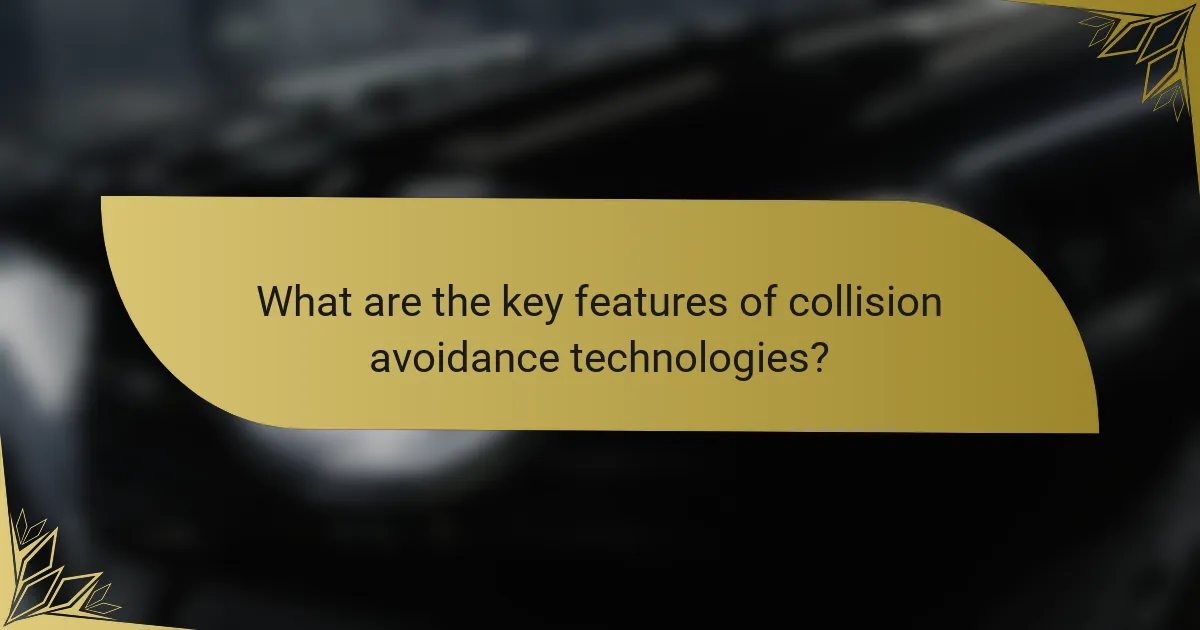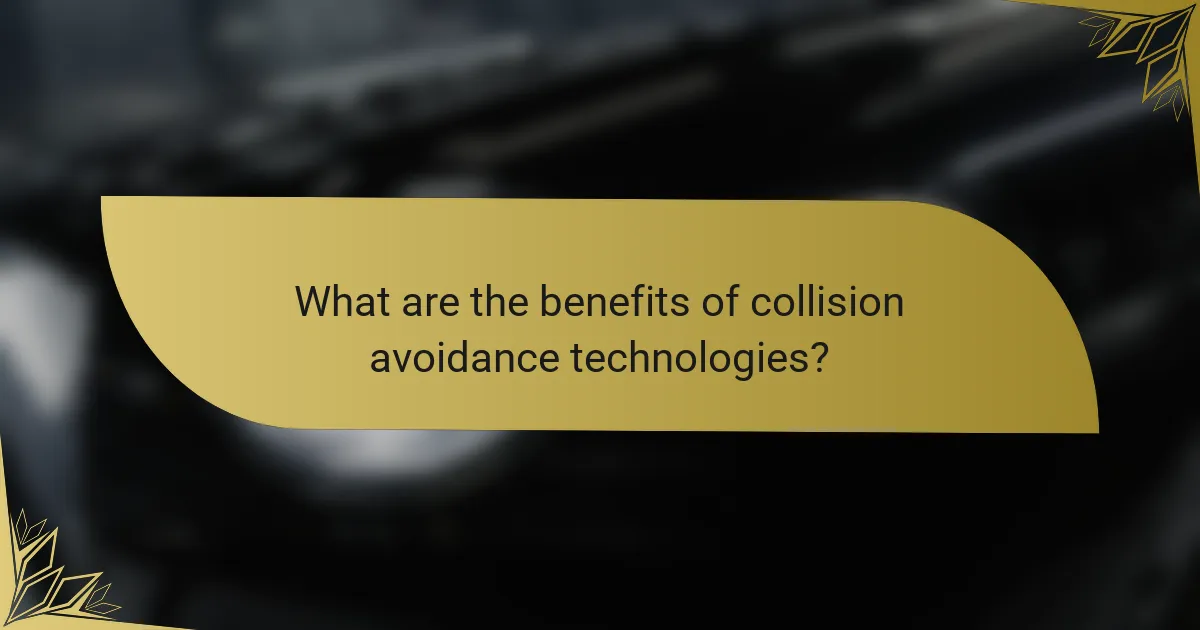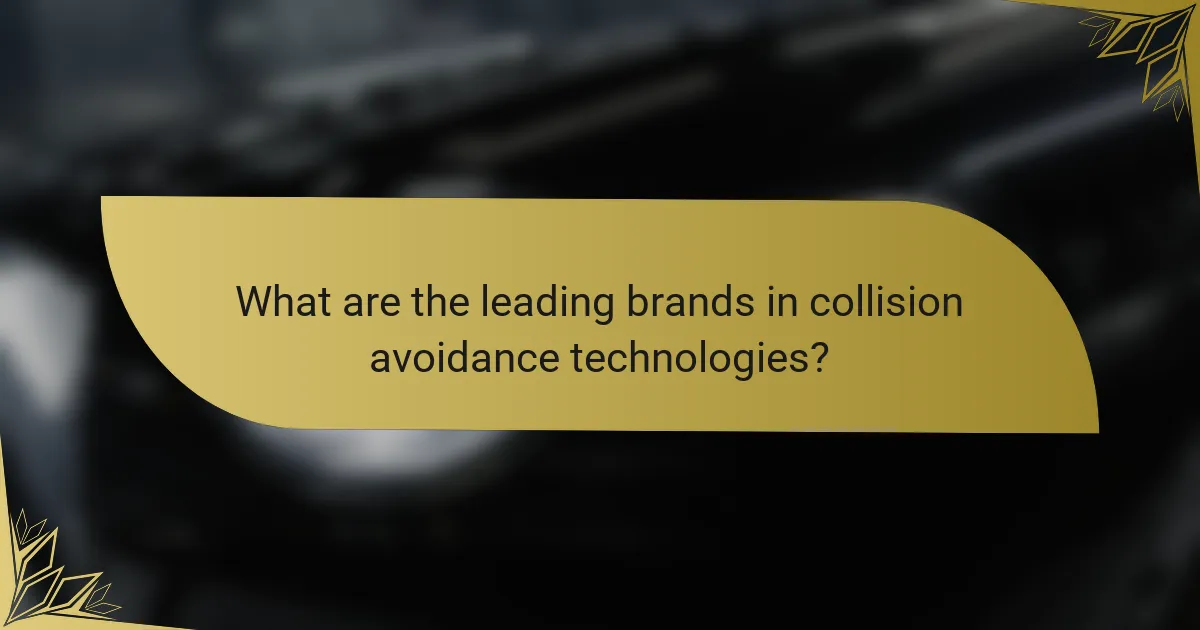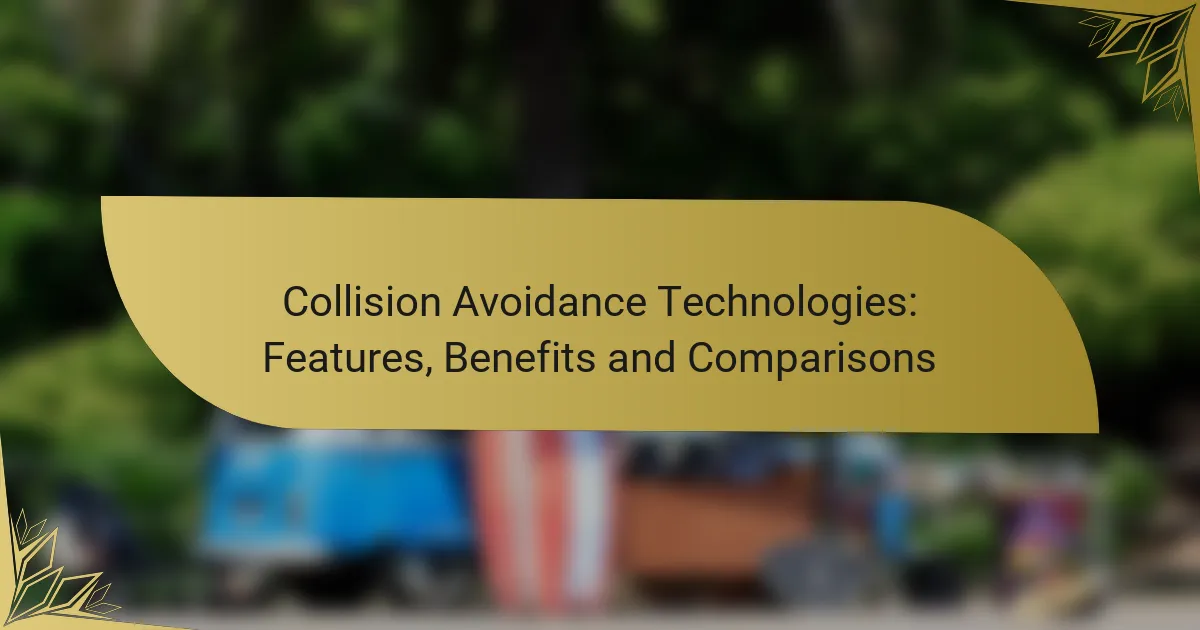Collision avoidance technologies play a crucial role in enhancing safety by detecting potential obstacles and either alerting the driver or automatically intervening to prevent accidents. With various sensing methods and data processing capabilities, these systems provide significant benefits, including reduced accident rates and improved overall safety. Understanding the differences in mechanisms and applications across automotive, maritime, and aviation contexts is essential for selecting the most suitable technology for specific needs.

What are the key features of collision avoidance technologies?
Collision avoidance technologies are designed to prevent accidents by detecting potential obstacles and alerting the driver or taking corrective action. Key features include various sensing methods, data processing capabilities, and communication systems that work together to enhance vehicle safety.
Radar-based systems
Radar-based systems use radio waves to detect objects around the vehicle, providing real-time information about distance and speed. These systems are effective in various weather conditions, making them reliable for applications like adaptive cruise control and blind-spot monitoring.
One advantage of radar is its ability to penetrate fog and rain, which can hinder other sensing technologies. However, it may struggle with distinguishing between multiple close objects, potentially leading to false alarms.
LiDAR technology
LiDAR (Light Detection and Ranging) technology employs laser beams to create a detailed 3D map of the vehicle’s surroundings. This high-resolution data allows for precise detection of obstacles, making it suitable for autonomous driving applications.
While LiDAR provides exceptional accuracy, it can be more expensive than other systems and may face challenges in bright sunlight or adverse weather. It is often used in combination with other technologies to enhance overall performance.
Camera-based detection
Camera-based detection systems utilize visual data to identify objects, lane markings, and traffic signals. These systems are crucial for features like lane-keeping assist and traffic sign recognition.
While cameras offer rich detail and context, they can be limited by lighting conditions and may require advanced image processing algorithms to function effectively. Combining cameras with other sensors can improve reliability and accuracy.
Sensor fusion capabilities
Sensor fusion integrates data from multiple sensing technologies to create a comprehensive understanding of the vehicle’s environment. By combining radar, LiDAR, and camera inputs, vehicles can achieve higher accuracy and reliability in detecting obstacles.
This approach helps mitigate the weaknesses of individual systems, providing a more robust collision avoidance solution. However, implementing sensor fusion requires sophisticated algorithms and processing power, which can increase costs and complexity.
Vehicle-to-vehicle communication
Vehicle-to-vehicle (V2V) communication enables cars to exchange information about their speed, direction, and location. This technology enhances collision avoidance by providing early warnings about potential hazards that may not be visible to the driver.
V2V communication can significantly improve safety, especially in complex traffic situations. However, widespread adoption depends on regulatory frameworks and the development of compatible systems across different manufacturers.

What are the benefits of collision avoidance technologies?
Collision avoidance technologies offer significant advantages, primarily enhancing safety and reducing the likelihood of accidents. These systems utilize sensors and algorithms to detect potential collisions, providing timely alerts or automatic interventions to prevent crashes.
Increased safety for drivers
Collision avoidance technologies significantly increase safety for drivers by actively monitoring their surroundings. Features such as automatic emergency braking and lane departure warnings help prevent accidents before they occur. This proactive approach allows drivers to focus more on the road, knowing that the system is working to protect them.
Moreover, these systems can assist in adverse weather conditions, where visibility may be compromised. By detecting obstacles that may not be immediately visible to the driver, collision avoidance technologies enhance overall driving safety.
Reduction in accident rates
Implementing collision avoidance technologies has been shown to lead to a notable reduction in accident rates. Studies suggest that vehicles equipped with these systems can reduce rear-end collisions by a significant percentage. This decrease not only benefits individual drivers but also contributes to safer roadways for all users.
As more vehicles incorporate these technologies, the cumulative effect can lead to lower overall traffic accident statistics, promoting a culture of safety on the roads. This trend is particularly evident in urban areas where traffic congestion is prevalent.
Lower insurance costs
Lower insurance costs are another compelling benefit of collision avoidance technologies. Insurers often provide discounts for vehicles equipped with advanced safety features, recognizing the reduced risk of accidents. This can lead to savings of several hundred dollars annually, depending on the coverage and provider.
Additionally, as collision avoidance systems become more common, the overall risk profile of insured vehicles improves, potentially leading to lower premiums across the board. Drivers should inquire about specific discounts related to these technologies when shopping for insurance.
Enhanced driver confidence
Enhanced driver confidence is a key benefit of collision avoidance technologies. Knowing that a vehicle is equipped with systems designed to prevent accidents can make drivers feel more secure on the road. This increased confidence can lead to more relaxed driving experiences, especially in challenging conditions.
Furthermore, as drivers become accustomed to these technologies, they may develop better driving habits, such as maintaining safe following distances and being more aware of their surroundings. This positive feedback loop can contribute to overall safer driving behavior.

How do collision avoidance technologies compare?
Collision avoidance technologies vary significantly in their mechanisms, effectiveness, and applications. Understanding these differences helps in selecting the right system for specific needs, whether in automotive, maritime, or aviation contexts.
Comparison of radar vs. LiDAR
Radar and LiDAR are two primary technologies used in collision avoidance systems. Radar uses radio waves to detect objects and measure their distance, making it effective in various weather conditions, including fog and rain. In contrast, LiDAR employs laser light to create high-resolution 3D maps of the environment, offering precise object detection but can be less reliable in adverse weather.
When choosing between radar and LiDAR, consider the operational environment. For example, radar may be preferable for long-range detection in poor visibility, while LiDAR excels in urban settings where detailed mapping is crucial.
Camera systems vs. sensor fusion
Camera systems rely on visual data to identify obstacles and lane markings, providing rich contextual information. However, they can struggle in low-light conditions or when faced with glare. Sensor fusion combines data from multiple sources, such as cameras, radar, and LiDAR, to enhance detection accuracy and reliability.
Using sensor fusion can significantly improve performance in complex environments. For instance, while a camera alone might misinterpret shadows as obstacles, sensor fusion can cross-reference data to reduce false positives.
Cost analysis of different technologies
The costs of collision avoidance technologies can vary widely based on the type and complexity of the system. Basic radar systems may start in the low thousands of USD, while advanced LiDAR setups can reach tens of thousands. Camera systems are generally more affordable but may require additional investment for sensor fusion capabilities.
When budgeting for collision avoidance technologies, consider not only the initial purchase price but also installation and maintenance costs. Investing in a comprehensive sensor fusion system may yield long-term savings through enhanced safety and reduced accident-related expenses.

What are the prerequisites for implementing collision avoidance systems?
Implementing collision avoidance systems requires specific vehicle compatibility and adherence to regulatory compliance standards. Understanding these prerequisites is essential for effective integration and operation of such technologies.
Vehicle compatibility requirements
Collision avoidance systems must be compatible with the vehicle’s existing hardware and software. This includes ensuring that the vehicle has the necessary sensors, such as cameras and radar, and that its onboard computer can process the data effectively.
Additionally, vehicles may need to undergo modifications to accommodate these systems. For instance, retrofitting older models might involve installing new electronic control units or updating firmware to support advanced features.
Regulatory compliance standards
Compliance with local and international safety standards is crucial for collision avoidance systems. In the United States, for example, the National Highway Traffic Safety Administration (NHTSA) sets guidelines that manufacturers must follow to ensure safety and reliability.
In Europe, the General Safety Regulation outlines requirements for advanced driver assistance systems (ADAS), including collision avoidance technologies. Manufacturers should familiarize themselves with these regulations to avoid legal issues and ensure market acceptance.

What are the leading brands in collision avoidance technologies?
The leading brands in collision avoidance technologies include well-known names such as Bosch, Mobileye, and Continental. These companies have developed advanced systems that enhance vehicle safety by preventing accidents through various innovative features.
Bosch
Bosch is a prominent player in the collision avoidance market, offering a range of systems that integrate radar, cameras, and ultrasonic sensors. Their technologies provide features like automatic emergency braking and lane-keeping assistance, which help drivers avoid potential collisions.
One of Bosch’s key offerings is the Vehicle Dynamics Control system, which enhances stability and control during emergency maneuvers. This system is designed to work seamlessly with existing vehicle safety features, making it a reliable choice for manufacturers.
Mobileye
Mobileye specializes in advanced driver-assistance systems (ADAS) that utilize computer vision and machine learning to detect potential hazards. Their systems are widely recognized for their effectiveness in collision prevention, particularly in urban environments.
Mobileye’s technology includes features such as pedestrian detection and traffic sign recognition, which provide real-time alerts to drivers. Their systems are often integrated into new vehicles, making them a popular choice among automakers looking to enhance safety.
Continental
Continental offers a comprehensive suite of collision avoidance technologies, including adaptive cruise control and blind-spot monitoring. Their systems are designed to improve driver awareness and reduce the likelihood of accidents.
Continental’s radar and camera-based solutions are particularly effective in providing 360-degree awareness around the vehicle. This holistic approach allows for better decision-making and enhances overall road safety.
